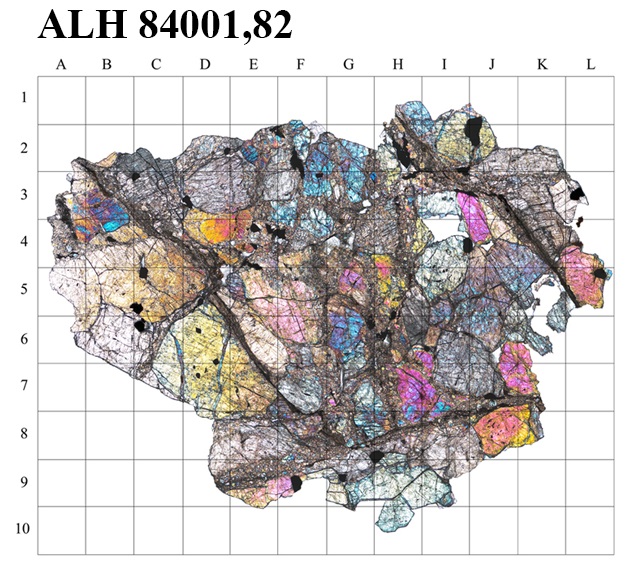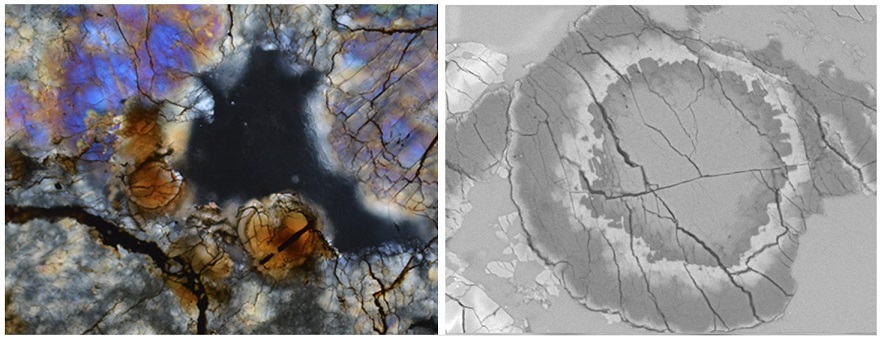What can be learned from Allan Hills 84001 carbonate globules about aqueous alteration processes in the Martian crust?
- 1Inst. for Space Sciences (CSIC), Meteorites, Minor Bodies and Planetary Sciences, Bellaterra (Barcelona), Catalonia, Spain (trigo@ice.csic.es)
- 2Institut d’Estudis Espacials de Catalunya (IEEC), Gran Capità 2-4, Ed. Nexus, desp. 201, 08034 Barcelona, Catalonia, Spain
- 3Universidad Internacional de Valencia (VIU), Carrer del Pintor Sorolla 21, 46002, Valencia, Spain
There is a very significant body of evidence for a dense Martian atmosphere during the Noachian period, about 3.8 Ga ago. At that point in the evolution of the red planet water was present in the surface of Mars, and ancient surface features indicate that it flew through significant regions of its surface. We have studied Allan Hills 84001. an orthopiroxenite formed about 4.1 Ga ago. It is a meteorite widely known because [1] found microscopic structures that were suggested to be magnetotactic microbe fossils. In particular, in our CSIC laboratory I have studied with some of my PhD students the carbonate globules contained in this meteorite [2]. We discovered in a ALH84001,82 thin section (Fig. 1) that they were formed near the rock fractures, as consequence of the precipitation of Mg- and Fe-rich carbonates from an aqueous solution.

Figure 1. Thin section of ALH 84001. The square grid is mm-sized. This optical microscope transmitted light reveals the main minerals forming the rock and many fractures as consequence, at least, of two impacts while the rock formed part of Mars’ surface. Water penetrated into the fractures and produced the carbonate globules (see also Fig. 2)
Interestingly, we found distinctive layers in the walls of the carbonate globules. They indicate that the globules growth occurred under several flooding stages. As they exhibit differentiated elemental chemistry, it could reflect distinctive chemical solutes, being probably evidence of chemically-distinguishable fluids produced by environmental differences [3-4]. To explain liquid water presence at that time is challenging because the young Sun was less luminous than today: about was ~25% lower than nowadays. Consequently, being Mars about 1.5 times more distant from the Sun than the Earth, the solar energy available on Mars was ~1/3 of what gets the Earth today. Then we need to invoke an atmospheric greenhouse effect. Early Mars atmospheric composition is not well constrained, but it was probably mostly composed of CO2 with a surface pressure between a few hundreds of mbars to a few bars [5]. Large amounts of CO2 and H2O were probably released by the substantial Tharsis volcanism during the mid-Noachian. These species probably contributed, but other greenhouse gases have been proposed to solve the enigma (Fig. 3). Some of them are photochemically unstable and rapidly exhausted, unless continuously outgassed by volcanoes. The discovery of sulphate salts in Mars’ surface [5] have promoted the relevance of SO2 as greenhouse, and strength the possibility of an astrobiological catalytic environment in presence of water and N-bearing species [3-4]. The study at microscale of Martian meteorites (exemplified with the previous ALH84001 study) can be useful to understand the geological context and get new insight about the presence of biosignatures.

Figure 2. ALH 84001 carbonate globules. Left) Optical microscope transmitted light where the rounded globules appear in brown. Right) One of the globules emphasized with a EDX mapping to show the different Fe-content of the layering.
Concerning the presence of water in Mars’ surface and subsurface at different epochs, the evidence arrived from Martian meteorites indicates a progressive water depletion probably due to the evolving surface environment, finally reaching the current harsh conditions. For example, clear evidence for Amazonian acidic liquid water on Mars surface was found, producing aqueous alteration minerals [5]. A dense atmosphere associated with volcanic outgassing during the Noachian period could have promoted significant deceleration, and disruption of fragile chondritic asteroids. In such circumstances the arrival of meteorite powders was a way to promote catalytic reactions at the Martian surface. Given that the early Mars was subjected to a continuous rain of chondritic materials when it experienced significant hydrothermal activity, I identify a potential astrobiology environment
All this growing evidence about the role of the aqueous alteration and the formation of secondary minerals also supports the evidence for a wet Mars environment. The role of collisional gardening in the early stages of Mars' evolution is also out of doubt from the study of the oldest Martian meteorites [6]. In fact, new evidence for a massive water sequestration has been recently presented [7]. To search for the pathways of water towards the interior of Mars we should study impact fractures in the crust of Mars, and their role to host potential biota. Probably the transient nature of aquifers in Mars was restricting the regions to develop life, but future mission searches in depth could get new clues.
ACKNOWLEDGEMENTS
This research has been funded by PGC2018-097374-B-I00 (MCI-AEI-FEDER, UE). US Antarctic meteorites are recovered by the Antarctic Search for Meteorites (ANSMET) program funded by NSF and NASA, and characterized and curated by the Department of Mineral Sciences of the Smithsonian Institution and Astromaterials Acquisition and Curation Office at NASA Johnson Space Center.
REFERENCES
[1] McKay D. S. et al. (1996) Search for Past Life on Mars: Possible Relic Biogenic Activity in Martian Meteorite ALH 84001. Science 273, 924-930.
[2] Moyano-Cambero, C.E., Trigo-Rodríguez, J.M., Benito, M.I., et al. (2017) Petrographic and geochemical evidence for multiphase formation of carbonates in the Martian orthopyroxenite Allan Hills 84001, Meteoritics & Planetary Science 52, 1030-1047.
[3] Trigo-Rodriguez, J. M., Moyano-Cambero, C. E., Donoso, J. A., Benito-Moreno, M. I., Alonso-Azcárate, J. (2018) Clues on Past Climatic Environments and Subsurface Flow in Mars from Aqueous Alteration Minerals Found in Nakhla and Allan Hills 84001 Meteorites, 49th LPSC, LPI Contribution No. 2083, id.1448
[4] Trigo-Rodríguez, J. M., Moyano-Cambero, C. E., Benito-Moreno, M. I., Alonso-Azcárate, J. (2018) Growth of carbonate globules in ALH 84001 Martian orthopyroxenite by transient floods in a chemically variable environment. Proceedings of the Mars Science Workshop From Mars Express to ExoMars, held 27-28 February 2018 at ESAC, Madrid, Spain, id.71
[5] Fernández-Remolar D.C. et al., (2011) The environment of early Mars and the missing carbonates. Meteoritics & Planetary Science, Volume 46, 1447-1469.
[6] Humayun M. et al. (2013) Origin and age of the earliest Martian crust from meteorite NWA 7533. Nature 503, 513-516.
[7] Scheller, E. L., Ehlmann, B. L., Hu, Renyu, Adams, D. J., Yung, Y. L. (2021) Long-term drying of Mars by sequestration of ocean-scale volumes of water in the crust. Science 372, 56-62.
How to cite: Trigo-Rodríguez, J. M. and Trišić, J.: What can be learned from Allan Hills 84001 carbonate globules about aqueous alteration processes in the Martian crust?, European Planetary Science Congress 2021, online, 13–24 Sep 2021, EPSC2021-803, https://doi.org/10.5194/epsc2021-803, 2021.

